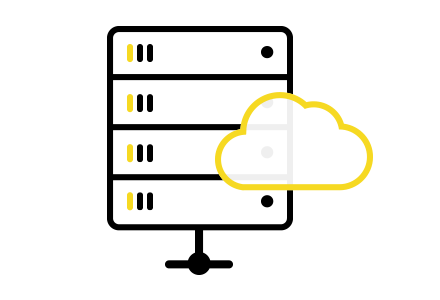This Kubernetes as a Service (KaaS) ensures a secure, scalable, and fully managed environment, perfect for companies looking to focus on development rather than infrastructure management.
The service is designed to enable customers to scale Kubernetes clusters both vertically and horizontally based on business needs. This environment is compatible with a variety of Seeweb products, such as Cloud Servers, VPC, GPU Cloud Servers.
Kubernetes stands out for its ability to handle and balance workloads in complex cloud environments. Thanks to its orchestration system, Kubernetes not only evenly distributes workloads among various containers but also ensures efficient resource utilization. This means that applications run with optimal performance, regardless of the volume or complexity of the workload.

Scalability is one of Kubernetes’ key features. The system can automatically manage the increase or decrease in resources (scaling up or scaling down) for applications based on real traffic and demand, facilitating resource expansion or reduction.
Kubernetes not only simplifies application deployment but also offers self-healing capabilities. If containers fail or become stuck, they are automatically replaced. This ensures operational continuity and service reliability, significantly reducing downtime.
Kubernetes Cluster and advanced architecture
Kubernetes is based on a flexible and robust cluster architecture, allowing efficient management and orchestration of containers on a large scale. This structure allows clusters to dynamically adapt to various workloads, thus ensuring optimal performance and reliability in any scenario.
Dynamic deployment an Kubernetes Pod
With Kubernetes, application deployment becomes more agile and controlled. By using Kubernetes Pods - the atomic units in the Kubernetes ecosystem - distribution and isolation of applications are optimized. Pods can contain multiple containers that share storage, network, and execution specifications.

-
What is Kubernetes?
The term Kubernetes derives from ancient Greek and means “helmsman”. The name perfectly reflects the platform's main function, which is to “steer” and orchestrate the container ecosystem, ensuring scalability, failover, and efficient distribution.
Kubernetes, often abbreviated as K8s (where 8 represents the number of letters between “K” and “s”), is an open-source system designed to manage the deployment, scaling, and management of containerized applications.
One of Kubernetes’ features lies in its ability to group containers into sets, which can be run on the same computer. This approach reduces network overhead and improves resource utilization efficiency. Kubernetes is particularly effective in managing and balancing resources among different containers, such as app servers, Redis caches, and SQL databases.
-
What is Kubernetes used for?
Kubernetes container management software has become the de facto standard for deploying and managing containerized applications. With its ability to simplify and automate numerous operations, Kubernetes has become a fundamental element in the IT strategies of many organizations.
Through automated container orchestration, reliability increases, and the time and resources required for daily operations are significantly reduced.
As a managed service, it offers versatile solutions for a wide range of needs:
- Accelerating development speed. By supporting both the creation of cloud-native apps based on microservices and the containerization of existing apps, it speeds up development and facilitates application modernization.
- Deploying applications anywhere. Kubernetes is designed to be used anywhere, allowing applications to be deployed wherever they are needed.
- Running efficient services. It can automatically adjust cluster sizes to run services, scaling applications based on demand and ensuring efficient execution.
-
Who uses Kubernetes?
Companies of various sizes and industries. Kubernetes is used by a wide variety of companies, ranging from innovative startups to large corporations. This platform is particularly popular among companies that need to manage complex applications distributed on a large scale. Industries such as fintech, e-commerce, media, healthcare, and many others rely on Kubernetes for its flexibility, scalability, and robustness.
Developers and IT teams. Developers and IT teams worldwide adopt Kubernetes to simplify and optimize the application deployment and management process. Kubernetes provides them with tools to automate and efficiently manage containers, allowing greater focus on development and innovation rather than infrastructure maintenance.
Cloud and modernization-oriented organizations. Organizations focusing on modernizing their applications and adopting cloud-native architectures find Kubernetes an essential tool. It is ideal for companies looking to leverage the benefits of cloud computing, including the ability to run applications in public, private, or hybrid cloud environments.
-
How does Kubernetes work?
To understand how Kubernetes works, it is essential to delve into its main components, which form the architecture on which the platform is based.
Master. This is the machine that coordinates the entire Kubernetes system. It performs critical functions such as dynamically allocating containers based on available resources and predefined parameters.
Nodes. Nodes are physical or virtual machines responsible for the actual execution of containers and applications. Each node is controlled by the master and can host one or more containers.
Pods. Pods represent the basic unit in Kubernetes. They can contain multiple containers residing on the same node, sharing, in addition to the IP address, computing, storage, and network resources.
Kubelet. Each node runs a process called Kubelet. This software agent runs on nodes and, receiving orders from the master machine, initiates container management according to instructions.
-
When to use Kubernetes?
When considering whether Kubernetes is the right choice for a company, it is essential to evaluate the potential benefits it can bring. Containerization, supported by Kubernetes orchestration, offers numerous advantages that can significantly improve technological efficiency, organization, and business benefits.
Ideal circumstances for adoption.
Companies looking to increase the flexibility of their application portfolio, accelerate development and release processes, ensure service continuity, and optimize IT costs will find Kubernetes a valuable ally. This technology is particularly beneficial in complex, heterogeneous, and distributed IT environments, where application portability and efficient management are crucial.Considerations for adoption.
dopting Kubernetes requires a thoughtful and personalized approach. The adoption roadmap must be gradual and well-planned, considering that integrating Kubernetes into existing IT infrastructure may require time and specific expertise. It is important to have a team with multidisciplinary expertise and adequate preparation to address technical and organizational challenges. -
What are Kubernetes pods?
Pods in Kubernetes are the smallest unit of an application within the Kubernetes ecosystem and represent a group of one or more containers. Each pod can contain multiple tightly coupled containers for advanced usage scenarios or a single container for more common scenarios. Within a pod, containers share the same computing resources and local network, allowing them to interact as if they were on the same physical hardware, while maintaining a certain level of isolation.
-
What are Kubernetes containers?
Kubernetes containers are a fundamental tool in the Kubernetes ecosystem. Containers are a way to package, deploy, and manage applications along with all their dependencies and necessary configurations, ensuring that the application runs consistently and reliably in any environment.
Kubernetes efficiently manages containers, providing advanced features such as automatic deployment, horizontal scalability, load balancing, version rollback, and more. By using Kubernetes to orchestrate containers, developers and system operators can focus on building and managing applications without having to worry about the underlying infrastructure.
-
What are the advantages of Kubernetes?
Kubernetes is the most sought-after container orchestration platform for valid reasons, including:
- Orchestration across different hardware systems. Kubernetes allows orchestrating containers across different hardware systems, optimizing resource usage, and ensuring high application performance.
- Service continuity and proper container operation. It ensures proper container operation and service continuity, crucial for critical applications.
- Software distribution and update automation. Automates software distribution and updates, reducing manual workload and the risks of human errors.
- Different security levels. It offers the possibility to set different security levels, thus protecting the infrastructure and applications from external threats.
- Automated operations. Kubernetes has built-in commands to manage many of the complex operations associated with application management, simplifying and speeding up development, release, and deployment processes.
- Infrastructure abstraction. Once installed, it manages computing, networking, and storage for workloads, allowing developers to focus on applications without having to manage the underlying environment.
- Service health monitoring. Performs continuous health checks, restarting containers that fail or are stuck, and making services available only after verifying their correct operation.
-
Understanding the main features of SKS
SKS is the Seeweb Kubernetes service based on European infrastructures that you can design with the support of our experts. SKS offers the best standards of compliance, guaranteeing continuity of service, load balancing, optimization of the operational costs.
The SKS architecture is extremely customizable and can be integrated with the wide range of cloud services hosted in our Data Centers.
The minimum configuration suggested by our experts is composed by at least 3 Worker Nodes, an asset that includes the service High Availability (HA).
For improving the Kubernetes architecture security, you can opt for VPN enterprise solutions like Fortinet FortiGate or for more standard security appliances (OPNsense).
The ideal support level for the financial sector, for SaaS providers, system integrators, public administrations, and in general for all the big and medium companies and organizations that want to enhance the efficiency and the uptime of their services through SKS, is represented by the Proactive Support. The “proactive” support option allows you to have an entire control rooms at your disposal, and a team of specialists for the proactive and predictive management of your infrastructure, the continuous monitoring of sites and applications, a constant analysis of the usage trends and of the infrastructure consumption.
-
What types of support are available on SKS?
On SKS, we offer proactive support (Proactive Support) that enables continuous and predictive monitoring of your Kubernetes cloud infrastructure. In addition to Proactive Support, we provide further levels of enterprise-grade assistance, including:
- Kubernetes DevOps Support, for DevOps activities on your Kubernetes clusters,
- Comprehensive Kubernetes Monitoring Support, for advanced and complete supervision of your environment.
Our support levels are designed to help you unlock the full potential of Kubernetes, without the burden of managing the technical architecture.
-
Can I integrate GPU Cloud Server with Kubernetes?
Certainly, it is possible to integrate GPU Cloud Servers with Kubernetes. Kubernetes supports the use of GPUs, which are particularly useful for compute-intensive workloads such as data processing for Artificial Intelligence or Machine Learning. By using GPUs in a Kubernetes environment, you can significantly increase the speed and efficiency of your containerized applications that require intensive computational power.



